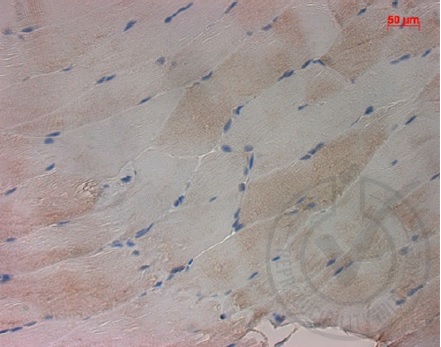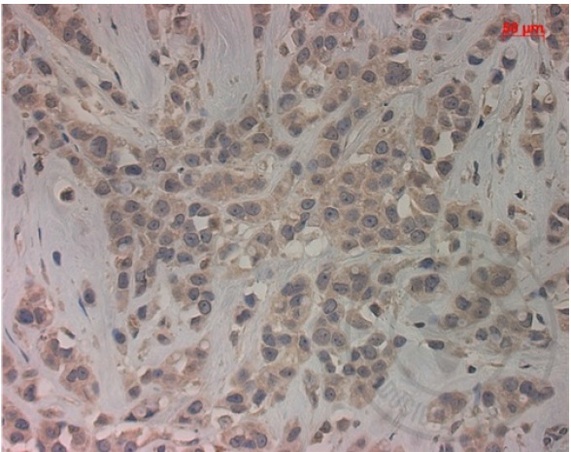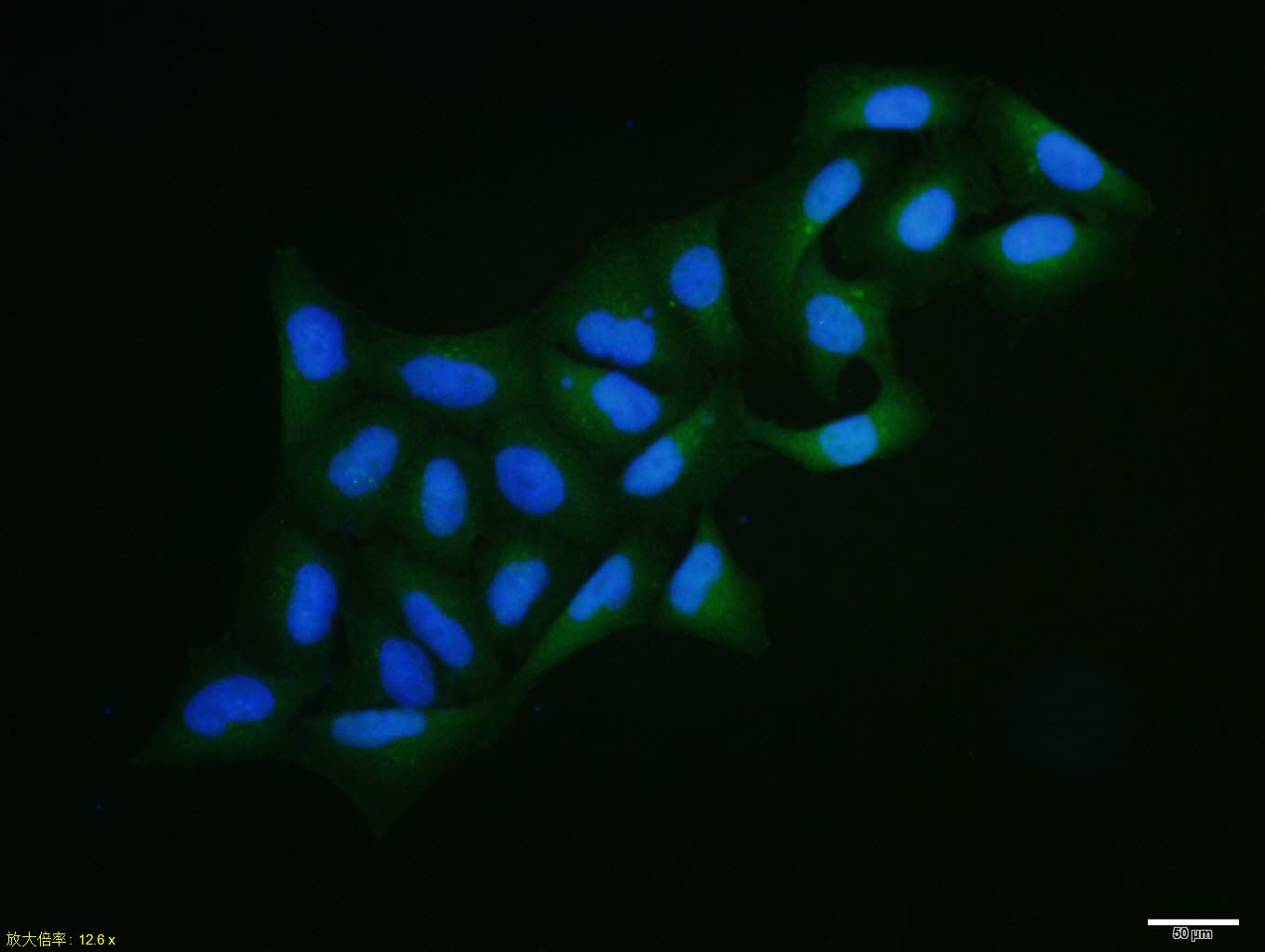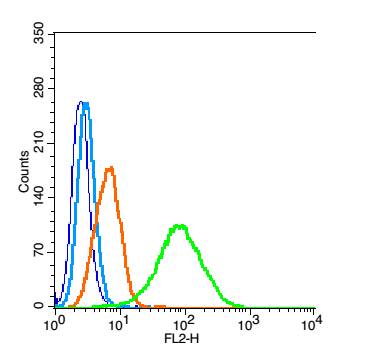
Rabbit Anti-PALB2 antibody
DKFZp667I166; 4732427B05; BC066140; DKFZp686E1054; FANCN; FANCN GENE; FLJ21816; OTTMUSP00000025884; PALB2; partner and localizer of BRCA2; RGD1304759; PALB2_HUMAN.
View History [Clear]
Details
Product Name PALB2 Chinese Name 乳腺癌易感基因相关蛋白2 Alias DKFZp667I166; 4732427B05; BC066140; DKFZp686E1054; FANCN; FANCN GENE; FLJ21816; OTTMUSP00000025884; PALB2; partner and localizer of BRCA2; RGD1304759; PALB2_HUMAN. Research Area Tumour Neurobiology Signal transduction Apoptosis Immunogen Species Rabbit Clonality Polyclonal React Species Human, Pig, (predicted: Mouse, Rat, Cow, ) Applications ELISA=1:5000-10000 IHC-P=1:100-500 IHC-F=1:100-500 Flow-Cyt=1μg/Test ICC=1:100 IF=1:100-500 (Paraffin sections need antigen repair)
not yet tested in other applications.
optimal dilutions/concentrations should be determined by the end user.Theoretical molecular weight 131kDa Cellular localization The nucleus Form Liquid Concentration 1mg/ml immunogen KLH conjugated synthetic peptide derived from human PALB2: 1101-1186/1186 Lsotype IgG Purification affinity purified by Protein A Buffer Solution 0.01M TBS(pH7.4) with 1% BSA, 0.03% Proclin300 and 50% Glycerol. Storage Shipped at 4℃. Store at -20 °C for one year. Avoid repeated freeze/thaw cycles. Attention This product as supplied is intended for research use only, not for use in human, therapeutic or diagnostic applications. PubMed PubMed Product Detail This gene encodes a protein that may function in tumor suppression. This protein binds to and colocalizes with the breast cancer 2 early onset protein (BRCA2) in nuclear foci and likely permits the stable intranuclear localization and accumulation of BRCA2. Essential partner of BRCA2 that promotes the localization and stability of BRCA2. Also enables its recombinational repair and checkpoint functions of BRCA2. May act by promoting stable association of BRCA2 with nuclear structures, allowing BRCA2 to escape the effects of proteosome-mediated degradation.
Function:
Plays a critical role in homologous recombination repair (HRR) through its ability to recruit BRCA2 and RAD51 to DNA breaks. Serves as the molecular scaffold in the formation of the BRCA1-PALB2-BRCA2 complex which is essential for homologous recombination. Strongly stimulates the DNA strand-invasion activity of RAD51, stabilizes the nucleoprotein filament against a disruptive BRC3-BRC4 polypeptide and helps RAD51 to overcome the suppressive effect of replication protein A (RPA). Functionally cooperates with RAD51AP1 in promoting of D-loop formation by RAD51. Essential partner of BRCA2 that promotes the localization and stability of BRCA2. Also enables its recombinational repair and checkpoint functions of BRCA2. May act by promoting stable association of BRCA2 with nuclear structures, allowing BRCA2 to escape the effects of proteasome-mediated degradation. Binds DNA with high affinity for D loop, which comprises single-stranded, double-stranded and branched DNA structures.
Subunit:
Homooligomer. Oligomerization is essential for its focal accumulation at DNA breaks. Part of a trimeric complex containing BRCA1, BRCA2 and PALB2. Interacts with BRCA1 and this interaction is essential for its function in HRR. Interacts with RAD51, BRCA2, RAD51AP1 and MORF4L1/MRG15.
Subcellular Location:
Nucleus. Note=Colocalizes with BRCA2 in nuclear foci.
DISEASE:
Breast cancer (BC) [MIM:114480]: A common malignancy originating from breast epithelial tissue. Breast neoplasms can be distinguished by their histologic pattern. Invasive ductal carcinoma is by far the most common type. Breast cancer is etiologically and genetically heterogeneous. Important genetic factors have been indicated by familial occurrence and bilateral involvement. Mutations at more than one locus can be involved in different families or even in the same case. Note=Disease susceptibility is associated with variations affecting the gene represented in this entry. Breast cancer susceptibility is strongly associated with PALB2 truncating mutations. Conversely, rare missense mutations do not strongly influence breast cancer risk (PubMed:22241545).
Fanconi anemia complementation group N (FANCN) [MIM:610832]: A disorder affecting all bone marrow elements and resulting in anemia, leukopenia and thrombopenia. It is associated with cardiac, renal and limb malformations, dermal pigmentary changes, and a predisposition to the development of malignancies. At the cellular level it is associated with hypersensitivity to DNA-damaging agents, chromosomal instability (increased chromosome breakage) and defective DNA repair. Note=The disease is caused by mutations affecting the gene represented in this entry.
Pancreatic cancer 3 (PNCA3) [MIM:613348]: A malignant neoplasm of the pancreas. Tumors can arise from both the exocrine and endocrine portions of the pancreas, but 95% of them develop from the exocrine portion, including the ductal epithelium, acinar cells, connective tissue, and lymphatic tissue. Note=The disease is caused by mutations affecting the gene represented in this entry.
Similarity:
Contains 7 WD repeats.
SWISS:
Q86YC2
Gene ID:
79728
Database links:Entrez Gene: 79728 Human
Entrez Gene: 233826 Mouse
Omim: 610355 Human
SwissProt: Q86YC2 Human
SwissProt: Q3U0P1 Mouse
Unigene: 444664 Human
Unigene: 38348 Mouse
Unigene: 43638 Rat
BRCA1,BRCA2和其他已经确定的易感性基因,只能解释不到一半的乳腺癌已知遗传性易感特征,芬兰科学家对113个有乳腺癌患者的家族进行了研究。他们在3个家族中发现了一种名为PALB2的基因,这种基因出现缺陷与家族成员患乳腺癌关系密切。PALB2基因与BRCA2基因在DNA修复中发生作用,新发现的突变会削弱这一功能。
研究结果表明,PALB2基因出现缺陷使这些家族成员患乳腺癌的危险增加3倍。另外,这一基因出现缺陷也使这些家族的男性成员患前列腺癌的危险增加。Product Picture
Antigen retrieval: citrate buffer ( 0.01M, pH 6.0 ), Boiling bathing for 15min; Block endogenous peroxidase by 3% Hydrogen peroxide for 30min; Blocking buffer (normal goat serum,C-0005) at 37℃ for 20 min;
Incubation: Anti-PALB2 Polyclonal Antibody, Unconjugated(SL0588R) 1:200, overnight at 4°C, followed by conjugation to the secondary antibody(SP-0023) and DAB(C-0010) staining
Hela cell; 4% Paraformaldehyde-fixed; Triton X-100 at room temperature for 20 min; Blocking buffer (normal goat serum, C-0005) at 37°C for 20 min; Antibody incubation with (PALB2) polyclonal Antibody, Unconjugated (SL0588R) 1:100, 90 minutes at 37°C; followed by a conjugated Goat Anti-Rabbit IgG antibody at 37°C for 90 minutes, DAPI (blue, C02-04002) was used to stain the cell nuclei.Blank control: Hela(blue), the cells were fixed with 2% paraformaldehyde (10 min) and then permeabilized with ice-cold 90% methanol for 30 min on ice..
Isotype Control Antibody: Rabbit IgG(orange) ; Secondary Antibody: Goat anti-rabbit IgG-FITC(white blue), Dilution: 1:100 in 1 X PBS containing 0.5% BSA ; Primary Antibody Dilution: 1μg in 100 μL1X PBS containing 0.5% BSA(green).
Bought notes(bought amounts latest0)
No one bought this product
User Comment(Total0User Comment Num)
- No comment







 +86 571 56623320
+86 571 56623320
 +86 18668110335
+86 18668110335

